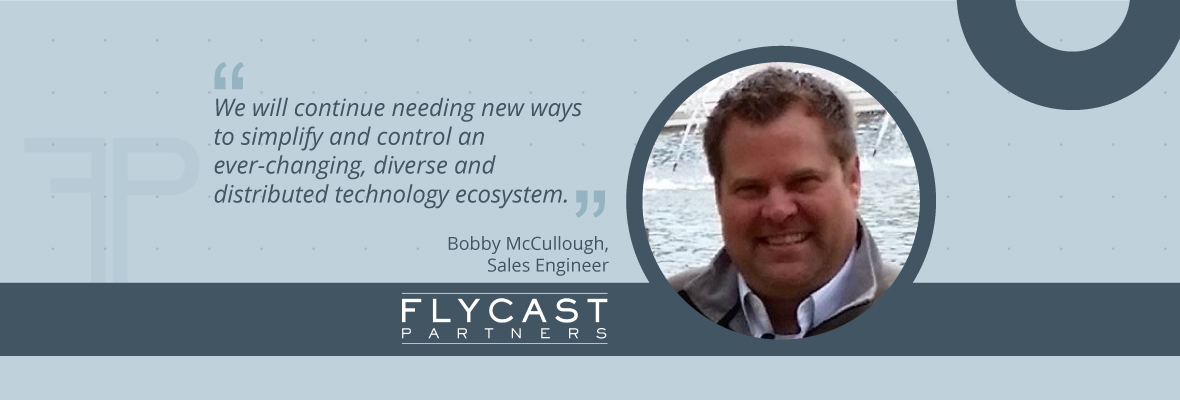Bobby McCullough is a Sales Engineer with Flycast, an IT service provider specializing in service management, asset management, security and IT operations management. Flycast uses OpsRamp internally and also resells the platform to its customers. He spoke with us about trends in ESM, ITSM and IT operations.
OpsRamp: How has Enterprise Service Management (ESM) changed over the years?
BM: The Amazon effect has had a big impact. For the last 20 years people have been ordering from Amazon. They don’t have to talk to anyone and they know when they will get their delivery. It just happens behind the scenes. Amazon is the “single pane of glass” for shopping. When people go to work they want that same experience. This has put the service desk under pressure, and they are shifting left to accommodate these demands and provide a single portal.
But it goes beyond a single pane of glass. It’s truly a culture change. What were previously disconnected and distinct business units must come together and digitally interact in a common platform. This can lead to technical as well as political issues. When each unit understands they are part of providing an “Amazon Experience”, the political barriers can be overcome.
OpsRamp: How about in IT operations?
BM: The same phenomenon is happening. The war room should be a thing of the past. These meetings often turn into an hour-long finger-pointing session. But if you use a modern IT operations management (ITOM) platform like OpsRamp, you can eliminate that because it is a single pane of glass that everyone can use. Then you can free up your people and be able to respond and fulfill requests in a reasonable timeframe. This need for the single pane of glass is only going to increase as the world changes around us.
OpsRamp: There’s been a convergence building recently between enterprise service management, IT service management and IT operations. Can you explain this trend?
BM: Service management is the oldest discipline of the three, and it continues to be refined. ITSM has been expanding into and merging with ESM, with the end goal of having a single pane of glass for all of service management. The same thing is happening in IT operations where we have all these different monitoring and change management tools. You don’t have to get rid of your tools, but they should be integrated so that you don’t have to respond to individual alerts, but instead you can manage the entire alert storm as one ticket. A platform like OpsRamp that can integrate this data provides the intelligence to make this happen; otherwise you’ve got somebody sifting through reports trying to make sense of it. It doesn’t scale.
OpsRamp: While the single pane of glass story sounds extremely logical, is it hard to sell?
BM: People across the business get married to their tools. Finance and HR people have their own portals and they don’t want to change nor have a single portal. This is of course the same dynamic in IT operations, service desk and DevOps. The network technician and the server admin each have their own toolsets. But it’s important to get people to understand the value of bringing those data sets together for a holistic view of business services, not components.
OpsRamp: Will tools simplification and the SPOG happen organically in time?
BM: There are more demands on IT than ever before and this pressure will keep accelerating, especially right now with Covid-19. Think about when we were all transitioning to work from home and how many IT organizations had to immediately provision laptops for people and then suddenly manage all these devices everywhere. This required new tools and processes for remote access. We will continue needing new ways to simplify and control an ever-changing, diverse and distributed technology ecosystem.
OpsRamp: What are some other issues that your customers are facing right now, as it relates to IT strategy, digital transformation or modernizing IT operations?
BM: Doing more with less is the mantra. Organizations are constantly striving to reduce their bottom line and anything that impacts it. Skimping on IT technology isn’t the best way to go but inevitably organizations must save where they can and oftentimes this means IT is left utilizing specific point tools that are usually provided for free with some technology that is purchased. The tools are just as separate and disconnected as our business units. And now we have to do this remotely. IT asset demands have increased – from acquiring assets, managing them, distributing and patching them. We have had tools for a while to do this remotely, but now it’s a matter of implementing them effectively so that we can respond faster and more proactively. None of these problems are new but scaling them while working remotely is the big challenge.
OpsRamp: When not working, how do you like to spend your time?
BM: I like being outside, whether that is family camping with our dogs at state parks near middle Tennessee or racing our little sailboat around the Southeast. I started racing nearly 20 years ago and have passed that passion onto my son who now helms when we race. Now that he’s in his last year of high school I suspect our racing will suffer for the next few years. My daughter (who would not be happy if she wasn’t mentioned) enjoys swimming. The sailboat can take her there…sometimes.





